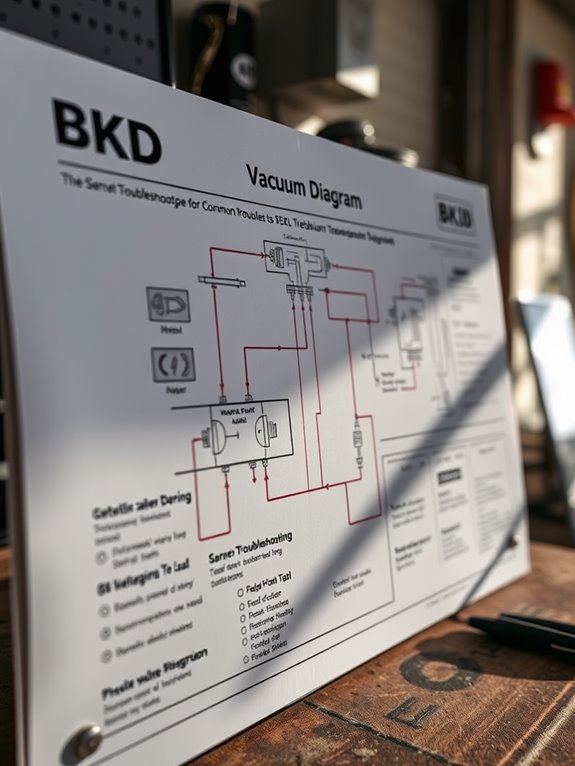Understanding BKD vacuum diagrams helps you navigate the complexities of particle interactions in theoretical physics. These diagrams simplify intricate processes, showcasing components like external lines for incoming particles and internal lines for virtual particles. By recognizing symbols and flow directions, you can interpret their significance. They’re not just theoretical tools; they have practical applications in areas like industrial processes and lab efficiencies. If you want to enhance your grasp on this topic, you’ll discover more insights ahead.
What Are BKD Vacuum Diagrams?

BKD vacuum diagrams are crucial tools in theoretical physics, particularly in the study of particle interactions.
These diagrams visualize complex interactions among particles in a simplified manner. You’ll notice that they represent virtual particles and their exchanges, helping you comprehend phenomena that aren’t directly observable.
By analyzing these diagrams, you can gain insights into how particles interact within a vacuum, where traditional methods might fall short. This approach allows you to explore the underlying principles of quantum field theory and advance your understanding of fundamental forces.
Fundamentally, BKD vacuum diagrams bridge the gap between abstract theory and practical applications in physics.
Components of a BKD Vacuum Diagram
At the heart of BKD vacuum diagrams are several key components that help depict particle interactions.
You’ll encounter external lines representing incoming and outgoing particles, typically denoting the initial and final states. Internal lines indicate virtual particles, showing intermediate interactions. Each vertex symbolizes a point where particles interact, illustrating fundamental forces at play.
Additionally, arrows on the lines indicate particle direction and type—whether they’re fermions or bosons. By recognizing these components, you’ll gain insight into the complex processes governing particle physics.
Understanding these elements is essential before diving into how to read and interpret the diagrams effectively.
You might also be interested in: Are Water Filtration Vacuums Better? Understanding Their Benefits
How to Read BKD Vacuum Diagrams

How can you effectively interpret BKD vacuum diagrams? Start by familiarizing yourself with the key symbols and lines that represent various components.
Then, follow these steps:
- Identify the flow direction: Arrows indicate how the vacuum moves through the system.
- Examine the pressure levels: Look for annotations that specify different pressure zones.
- Check for connections: Verify all components are properly linked, as this affects overall functionality.
Common Applications of BKD Vacuum Diagrams
BKD vacuum diagrams play a vital role in various fields, helping you optimize industrial processes and enhance laboratory research efficiency.
You’ll find their applications extend to environmental monitoring solutions as well, making them versatile tools in many settings.
Understanding these common applications can greatly improve your approach to problem-solving in these areas.
Industrial Process Optimization
While enhancing industrial processes, understanding BKD vacuum diagrams can greatly improve efficiency and productivity.
By visualizing the vacuum system’s performance, you can identify areas for improvement. Here are three common applications where BKD vacuum diagrams make a difference:
- Leak Detection: Quickly spot leaks in vacuum lines, minimizing downtime and material loss.
- System Balancing: Certify ideal airflow and pressure distribution across your processes, leading to consistent product quality.
- Energy Efficiency: Analyze energy consumption patterns, helping you reduce operating costs and environmental impact.
Embracing BKD vacuum diagrams allows you to streamline operations and achieve better results.
Laboratory Research Efficiency
Maximizing laboratory research efficiency hinges on the effective use of BKD vacuum diagrams. These diagrams help you visualize and optimize vacuum conditions, ensuring experiments run smoothly.
By identifying potential bottlenecks and inefficiencies, you can streamline processes and reduce downtime. You’ll find that using BKD diagrams allows for better resource allocation, enabling your team to focus on critical tasks.
They also aid in troubleshooting, helping you quickly pinpoint issues before they impact results. Ultimately, integrating BKD vacuum diagrams into your workflow not only saves time but also enhances the quality and reliability of your research outcomes.
Environmental Monitoring Solutions
When it comes to environmental monitoring solutions, BKD vacuum diagrams play an important role in guaranteeing accurate data collection and analysis.
These diagrams help you visualize and manage vacuum systems effectively, vital for maintaining environmental standards.
Here are three common applications where you’ll find BKD vacuum diagrams invaluable:
- Air Quality Monitoring: Analyze pollutants and guarantee compliance with regulations.
- Water Quality Analysis: Track contaminants and maintain safe water standards.
- Soil Testing: Assess soil health and its impact on ecosystems.
Troubleshooting Common Issues in BKD Vacuum Diagrams

When troubleshooting BKD vacuum diagrams, you’ll want to start by identifying common failures that can disrupt performance.
Pay close attention to any pressure fluctuations, as they often signal underlying issues.
Identifying Common Failures
Identifying common failures in BKD vacuum diagrams can save you time and prevent costly repairs.
Here are three issues to watch for:
- Leaks in the System: Check for any signs of air leaks, as they can severely impact performance.
- Blockages: Inspect tubing and valves for obstructions that may hinder airflow and efficiency.
- Faulty Sensors: Verify sensors are functioning correctly, as inaccurate readings can lead to improper adjustments.
Analyzing Pressure Fluctuations
Analyzing pressure fluctuations in BKD vacuum diagrams is essential for maintaining ideal system performance.
Regularly monitor pressure readings to identify irregularities that could signal issues. If you notice sudden drops or spikes, check for leaks or obstructions in the system. These fluctuations might indicate faulty components, so inspect valves and gauges for wear or malfunction.
Additionally, verify that the vacuum pump operates efficiently, as inconsistent performance can lead to pressure instability. By addressing these concerns promptly, you can prevent more significant problems and verify smooth operation in your BKD vacuum system.
Stay proactive to keep everything running smoothly.
Best Practices for Maintaining BKD Vacuum Systems
To assure optimal performance of your BKD vacuum systems, it’s crucial to follow a set of best practices that will enhance their longevity and efficiency.
Here are three key tips:
- Regular Maintenance: Schedule routine checks and cleaning to guarantee all components are functioning at their best.
- Monitor Performance: Keep an eye on pressure levels and make adjustments as necessary to prevent system strain.
- Use Quality Parts: Invest in high-quality replacement parts to avoid failures and maintain system integrity.
Conclusion
In summary, mastering BKD vacuum diagrams can feel like opening a secret door to efficient systems and troubleshooting. By understanding their components and applications, you’ll navigate any challenges that arise with confidence. Remember, regular maintenance is key to keeping your vacuum systems running smoothly. So, plunge into, explore these diagrams, and watch your expertise grow like a well-tended garden. With practice, you’ll become a pro at harnessing the power of BKD vacuum systems!

I’m Allen Kim, the chief editor of plumbinginto. I am a mid level plumber and assign to an local firm over 4 years of experience. During the working period, most of my experience is related to the house plumbing. I learned about the thing, when working with most experienced people in this sector, one must be as good as the inspector or better with knowledge of the project as well as the practical aspects of plumbing industry.